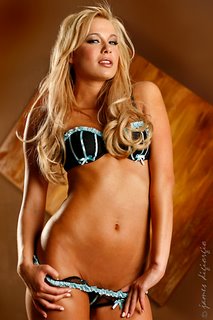 This one's aimed at some of you hobbyists out there. Not the experienced ones but you people who are starting out learning the craft of photography and, more specifically, studio lighting.
This one's aimed at some of you hobbyists out there. Not the experienced ones but you people who are starting out learning the craft of photography and, more specifically, studio lighting. Here's the bad news: Shop lights suck for photography.
I'm writing about this because there was a thread on Glamour1 today where a shooter posted a pic of a model showing his first attempt at studio lighting. He used shop lights and, of course, the light was stark, flat, and unappealing. Coupled with what looked like minimal post-processing skills, the image (of a very pretty model) simply didn't work.
Here's what I wrote as a critique of his image. (He posted it in the "Photo Review & Critique" sub-forum.)
"Don't take this as me being unkind or elitist but the odds of you or anyone else who is new to shooting in a studio and who are using shop lights and who are hoping to capture images that are dynamic, polished, and professional-looking are remote. More than likely, doing so would be accidental and/or the product of dumb luck.
Shooting portraiture with shop lights and obtaining great results requires greater skill than shooting with lighting designed for such uses. Shop lights are, by their own design, popular with many people using them for many applications because of their ability to scatter a lot of light, flatly and broadly. Controlling and modifying shoplights, for photographic purposes, is difficult at best.
My suggestion: If you're serious about shooting studio portraits and even if you're on a shoestring budget get yourself some lights that are designed for use in photography. Heck, even old camera-mounted strobes (which you can find at swap meets, thrift stores, and yard sales) can be adapted to stands or in other ways to hold them in place and will be easier to control and modify than shoplights. Plus, they'll keep color temperature better. Or, buy the really, really cheap strobes on eBay. You don't need the bells and whistles that expensive gear costs. Maybe you'll have to wait for them to recycle a bit longer and maybe you'll have to treat them gingerly to keep from breaking and maybe the color temp will drift a bit but, again, they will be infinitely better for your development as a shooter than shop lights."
 Now that I'm reading this again, I see my repsonse wasn't very well written but I think I got the point across. Hopefully and especially the part about it taking MORE skill to get good results with shop lights.
Now that I'm reading this again, I see my repsonse wasn't very well written but I think I got the point across. Hopefully and especially the part about it taking MORE skill to get good results with shop lights. Shop lights throw light everywhere! Besides being HOT (easy to burn yourself or the model with them) and a potential fire danger, they're extremely unwieldy to control and/or modify. If you're going to start learning studio/portrait photography, get yourself one of those cheap JTL or other monolights off of eBay and begin practicing with a single light, then adding reflectors for fill. (DIY reflectors work great!)
Shoplights are like 800 lb. gorillas when it comes to portrait photography. You might think it's a good idea to invest an awful lot of time developing your shoplight portrait-style but, personally, I think you're better off developing a more rewarding portrait style and you're only going to do that with gear that's intended for that use. Hey! Some of you people have spent thousands on cameras and lenses. What's a hundred bucks or so for a real strobe?
Eye-candy posted with this little anti-shoplight rant is Stefani. I shot Stefani the other day while working the Tera Patrick production. She's really cute, ain't she? And that's a world-class behind on that young lady! The color is a little different on the second one as I added a gel to warm things up when I turned her around and faced her into the kicker, camera-left. I'll post more images of Stefani in future updates.

3 comments:
Perhaps I should have entitled my previous comment "size matters." After all, that's all I meant to say: the size of the light source relative to the subject determines how "hard" or "soft" the light source is. Using silks or other forms of diffusion does nothing more that increase the relative size of the light source.
Hi JIMMYD,
It's all very good read and I like coming back and reading what you have to say. To be honest, mostly I'm hoping to pick up some details on how you used lights, reflectors and so on - please include even more of it if you can :)
Other then that it's all pretty educational and entertaining. Love it man!
Cheers,
Dream
Don't mean to seem like a pill, but the post that showed up here (#2 of 2) does not make much sense without the first one. So I'll just say that if you're a newbie go off and look up the terms "umbra" and "penumbra" and you'll understand everything there is to know about lighting chicks or anything else you might ever have to point a lens at.
Post a Comment